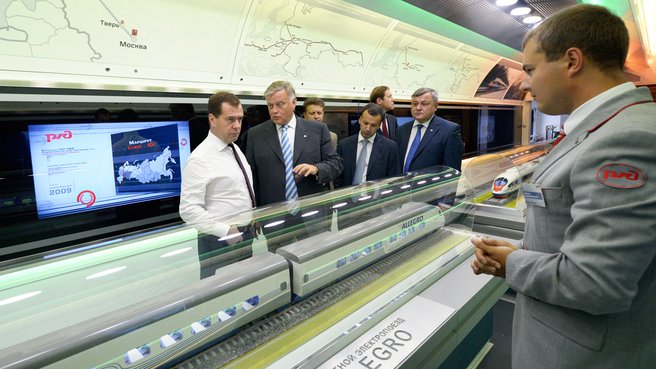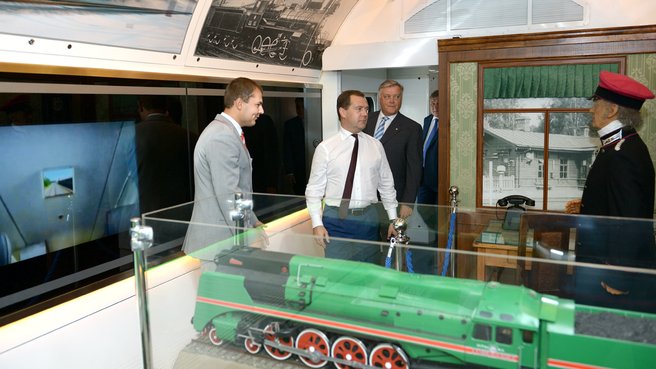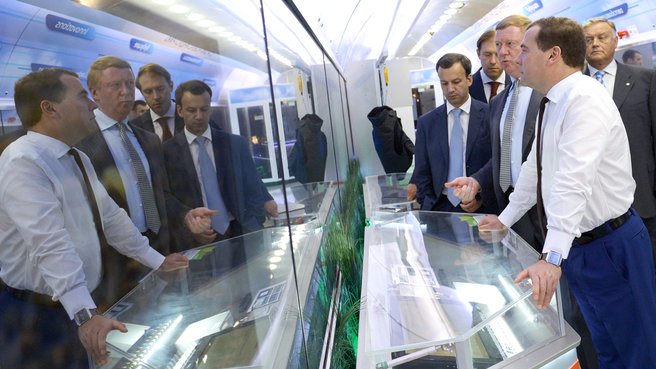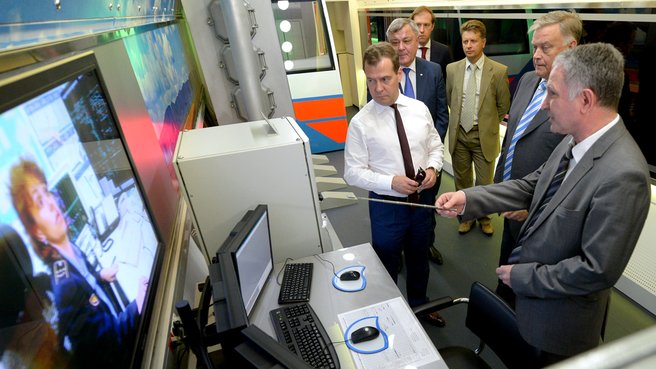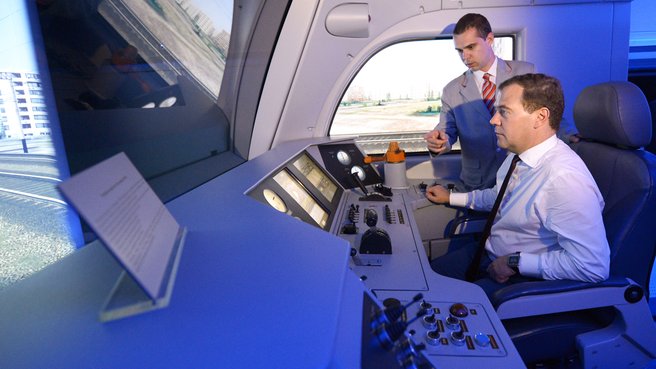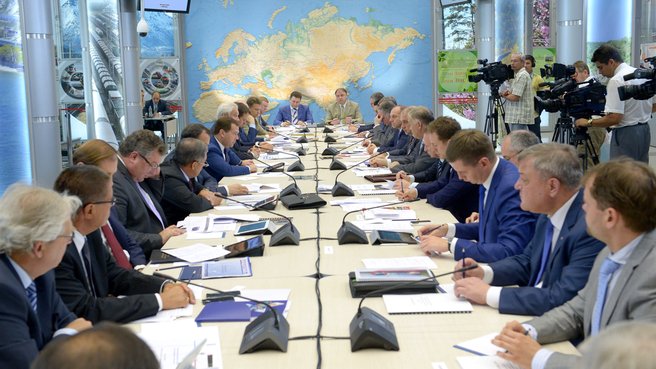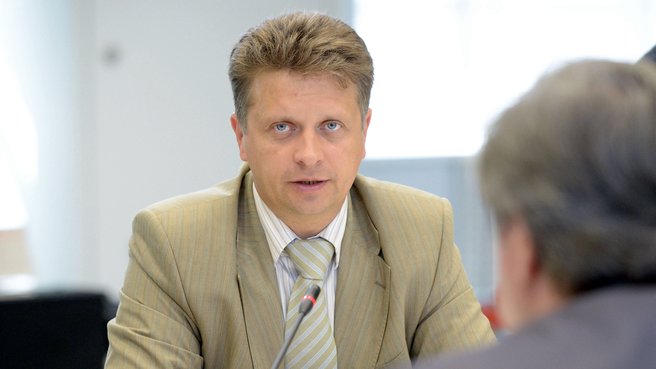The meeting focused on innovative development of rail transport.
Before the Presidium meeting, Dmitry Medvedev toured Russian Railways’ mobile exhibition and lecture centre located at the Rizhsky Railway Station in Moscow
The Prime Minister was shown a model of the Sapsan train that runs between Moscow and St Petersburg, and familiarised himself with the features of the Allegro and Lastochka high-speed trains.
During the tour, Dmitry Medvedev was told about different train control systems, in particular, a special system for transmitting information over the rails.
The Prime Minister also viewed the stand for a computer-controlled hump detection system and familiarised himself with energy saving and air cleaning and disinfecting systems, as well as the innovative materials used to build rail infrastructure.
At the end of the tour, the Prime Minister sat in a model cockpit and, using interactive control knobs with help from an instructor, “drove” a passenger train to the Leningradsky Railway Station.
***
Transcript:
Beginning of the meeting of the Council for Economic Modernisation and Innovative Development presidium
Dmitry Medvedev: Good afternoon, everyone. Colleagues, our meeting today is in a special place, and this has determined the agenda of this Presidium meeting of the Council for Economic Modernisation and Innovative Development. Today, we will be talking about the innovative development of rail transport. As you may recall, in 2012, we marked the 175th anniversary of Russian Railways, which is among the top three international railway operators. Rail transport has always played and will always play a huge role in the life of our country, because of the vastness of its territory. In fact, it accounts for more than 40% of passenger and freight traffic.
It is, therefore, clear that the industry needs the latest technology. Sometimes, the term “railway transport” conjures up images of last century’s steam trains, which used fairly conventional technology. In fact, this is absolutely not true. Russian Railways is the main customer of the latest technology. Of course, we will be able to solve difficult tasks, such as increasing the speed, which is mandatory in the 21st century, overall safety, affordability and comfort of passenger trains only with the help of modern technology and advanced designs. I have toured the exhibition with Mr Yakunin (Vladimir Yakunin, Russian Railways President and Chairman of the Board) and other colleagues. We are faced with a variety of complex tasks. Among other things, we should minimise the environmental impact. This is a hot topic, and 2013 is the Year of the Environment. There are modern technologies that address these problems.
As you are aware, we spoke about minimising environmental impact and using modern technology at the previous meeting of the Presidium. Clearly, it’s important to cut costs, increase efficiency in the industry and promote what is called the responsiveness of the industry to the interests of consumers and suppliers, especially in order to cap the growth of prices for services.
Several important documents stipulating the innovative areas of development in rail transport have been adopted at the federal level.
In accordance with the Transport Development Strategy to 2030 adopted in 2008, we will focus our efforts on high-speed passenger trains that can reach speeds of 400 km/h. Of course, this is a special breed of rail transport. The so-called heavy-weight cargo traffic is another area of focus. Clearly, all this toughens requirements on rolling stock and the infrastructure. I will outline some of the key issues.
First, the demand for design and construction technology and the production of materials, including the composites that we just saw, and the creation of new types of equipment. If the demand is there, then the engineering and metallurgical companies should start working on it and upgrade their equipment and build production sites in order to be able to handle future orders.
The industry has a toolset for the job. Nothing fantastic, but still something. These are the government support tools, such as interest rate subsidies on loans for retrofitting and other things.
Perhaps long-term, steady orders by Russian Railways is the key, or, at least, an important prerequisite. If there are orders, the production and investment planning will follow. A number of price decisions have been taken that include reducing infrastructure costs in the operation of innovative technology. These decisions should stimulate the buyer to opt for a new product. This practice should be further expanded. I’m referring to some of the documents that the Federal Tariff Service adopted in 2012 and 2013. You are aware of them, no need to name them now.
My second point is about continued technical cooperation with leading international partners. Russian Railways has such partners, they are Siemens and Alstom. That said, we have to make efforts to achieve maximum possible localisation in the production of main component parts and junctions, and we have successful experience in this. For certain products, localisation has reached 80%. But we must adopt not only advanced engineering solutions but also approaches to production planning and organisation, which can be just as complicated. It is equally important for the company to organise target training of specialists who can work with such equipment. This is a new level equipment, but it is no different from that used in other types of transport that have already been modernised.
Third, there is the company’s own research and development work, which is underway – such as the work to develop LPG-driven gas turbine locomotives. We just checked out one of the items, a hybrid drive diesel locomotive that saves fuel. I should also add that a new generation of diesel engines is being developed with state support.
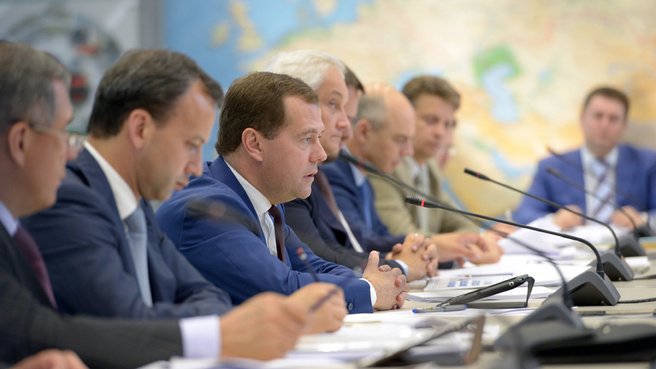
Meeting of the Presidium of the Presidential Council for Economic Modernisation and Innovative Development
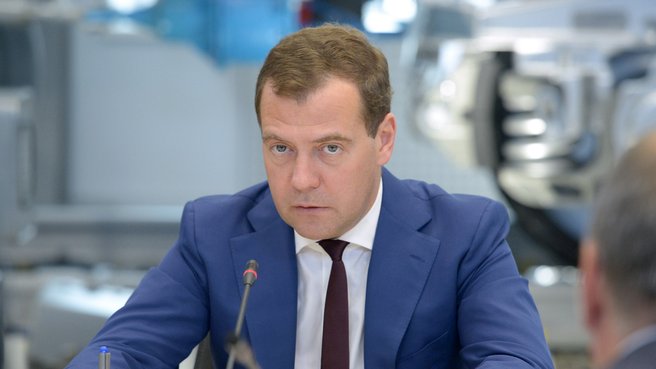
Meeting of the Presidium of the Presidential Council for Economic Modernisation and Innovative Development
Meeting of the Presidium of the Presidential Council for Economic Modernisation and Innovative Development
Fourth is the financing levels. It is good that the company, by which I mean Russian Railways, is involved in this, but despite it being a large infrastructure monopoly, it is obvious that the financing will not be enough for everything. Yet, the amounts of financing for branch research from institutes, other participants in the process, stand at 40 billion roubles, a substantial volume. The projects in the field are supported by Rusnano, Vnesheconombank and Skolkovo. These resources have to be used actively. Grants are being provided in different forms, and we are also expecting the implementation of the resulting developments.
Fifth is the decision that has been taken to use part of the National Wealth Fund’s resources for recouped infrastructure projects (at least we hope they will be recouped). These include the project to build the Moscow-Nizhny Novgorod-Kazan high-speed railway, which has already been approved at parliamentary hearings. Another project is modernising the Trans-Siberian Railway. These are large and serious projects. For a long time, there has been a great deal of disagreement on whether we should allocate the money now when we don’t have much resource. But the decision has been made, and this will create a multiplier effect for other sectors and participants in the process. Its implementation will require comprehensive cooperation among the transport, construction and industrial complexes, and the involvement of national scientific and educational centres at the current stage of engineering and technology auditing.
Another thing I would like to mention is that Russian manufacturers of railway equipment are able not only to strengthen their position on the domestic market but also take a notable position at the so-called 1520 space. The main tools for solving related tasks have been developed and priority fields have been specified. Now we have to rationally distribute the available resources.
In conclusion, I would like to say that in the past few years the overall development of the sector and rail transport has been active. We see new items appear. Recently, I attended the launch of one such item, and it is being used now. This is good. All this research and work have to be performed at the highest level, especially since the sector employs a vast number of people and they should have adequate working conditions, as the railway has always been and will always be a source of heightened danger. This is unfortunately proved not by some theoretical research but by ordinary life experience.
The recent tragedy in Siberia claimed five lives. I believe Mr Yakunin will see what has to be done for the victims’ families. And, of course, a proper investigation has to be conducted. This just proves what I have said: innovative development of railways has to be based on modern standards and the strongest safety requirements.
<...>
